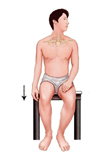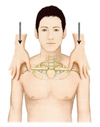Abstract
Thoracic outlet syndrome (TOS) is an uncommon condition that can occur when the nerves, artery, or vein to the arm is compressed by one or more of the structures that make up the thoracic outlet. TOS was the first compression neuropathy of the upper extremity to be identified. The wide variability of patients' symptoms, which include vascular and neural signs, as well as diffuse symptoms, and the lack of a valid and reliable test to confirm the diagnosis of TOS makes it difficult to identify correctly patients with TOS. Rates of three to 80 cases per 1,000 patients have been reported, but more patients are likely to have TOS because it is underestimated. Additionally, the primary controversy regarding patients with TOS is related to symptoms such as paresthesia, numbness, and pain. No positive objective test exists to confirm an accurate diagnosis. If patients present with diffuse pain and numbness in the neck and upper extremity with more than 2 provocation tests, TOS could be considered. The purpose of this review is to provide an overview of the causes, classification, evaluation, and management of TOS.
Figures and Tables
 | Figure 1Anatomy of thoracic outlet. The subclavian artery, vein, and brachial plexus are passing through the anterior scalene muscle. Reproduced from Korean Orthopaedic Association. Orthopaedics. 7th ed. Seoul: Korean Orthopaedic Association; 2013, with permission from Young-Ho Kwon [16]. |
 | Figure 2Hyperabduction test. Shoulder abducted above 90° and arm hyperabducted to 180° leads to diminishing radial pulse. Neurovascular structures compressed in subcoracoid region by pectoralis minor tendon, head of humerus or coracoid process. Reproduced from Korean Orthopaedic Association. Orthopaedics. 7th ed. Seoul: Korean Orthopaedic Association; 2013, with permission from Young-Ho Kwon [16]. |
 | Figure 3Neck tilt test. Neck rotation with arms at the side eliciting neck and arm pain, discomfort and paresthesia down the contralateral side. Reproduced from Korean Orthopaedic Association. Orthopaedics. 7th ed. Seoul: Korean Orthopaedic Association; 2013, with permission from Young-Ho Kwon [16]. |
 | Figure 4Costoclavicular compression test. Shoulder retracted and depressed leads to diminish radial pulse and/or arm pain and paresthesia. Reproduced from Korean Orthopaedic Association. Orthopaedics. 7th ed. Seoul: Korean Orthopaedic Association; 2013, with permission from Young-Ho Kwon [16]. |
References
2. Wilbourn AJ. Thoracic outlet syndrome surgery causing seve-re brachial plexopathy. Muscle Nerve. 1988; 11:66–74.

5. Khatib N, Boulet J. Thoracic outlet syndrome: a congenital case manifesting in middle age. CMAJ. 2015; 187:206.

6. Vu AT, Patel PA, Elhadi H, Schwentker AR, Yakuboff KP. Tho-racic outlet syndrome in the pediatric population: case series. J Hand Surg Am. 2014; 39:484–487.

7. Keen WW. The symptomatology, diagnosis and surgical treat-ment of cervical ribs. Am J Med Sci. 1907; 133:175–217.

8. Murphy T. Brachial neuritis caused by pressure of first rib. Aust Med J. 1910; 15:582–585.
9. Reichert FL. Compression of brachial plexus: the scalenus anticus syndrome. JAMA. 1942; 118:294–296.

10. Adson AW, Coffey JR. Cervical rib: a method of anterior approach for relief of symptoms by division of the scalenus anticus. Ann Surg. 1927; 85:839–857.
11. Adson AW. Surgical treatment for symptoms produced by cervical ribs and the scalenus anticus muscle. Surg Gynecol Obstet. 1947; 85:687–700.
12. Peet RM, Henriksen JD, Anderson TP, Martin GM. Thoracic-outlet syndrome: evaluation of a therapeutic exercise program. Proc Staff Meet Mayo Clin. 1956; 31:281–287.
13. Clagett OT. Presidential address: research and prosearch. J Thorac Cardiovasc Surg. 1962; 44:153–166.
14. Roos DB. Transaxillary approach for first rib resection to reli-eve thoracic outlet syndrome. Ann Surg. 1966; 163:354–358.

15. Sanders RJ, Pearce WH. The treatment of thoracic outlet syndrome: a comparison of different operations. J Vasc Surg. 1989; 10:626–634.

16. Korean Orthopaedic Association. Orthopaedics. 7th ed. Seoul: Korean Orthopaedic Association;2013.
17. Fodor M, Fodor L, Ciuce C. Anomalies of thoracic outlet in human fetuses: anatomical study. Ann Vasc Surg. 2011; 25:961–968.

18. Rustum S, Rodt T, Teebken O, Schrimpf C, Aper T, Wilhelmi M. Unusual case of an arterial thoracic outlet syndrome due to Srb anomaly. Thorac Cardiovasc Surg Rep. 2013; 2:50–52.

19. Chandra V, Little C, Lee JT. Thoracic outlet syndrome in high-performance athletes. J Vasc Surg. 2014; 60:1012–1017.

20. Kuhn JE, Lebus V GF, Bible JE. Thoracic outlet syndrome. J Am Acad Orthop Surg. 2015; 23:222–232.

21. Palmer OP, Weaver FA. Bilateral cervical ribs causing cerebel-lar stroke and arterial thoracic outlet syndrome: a case report and review of the literature. Ann Vasc Surg. 2015; 29:840.e1–840.e4.

22. Brantigan CO, Roos DB. Etiology of neurogenic thoracic out-let syndrome. Hand Clin. 2004; 20:17–22.

24. Likes K, Rochlin D, Nazarian SM, Streiff MB, Freischlag JA. Females with subclavian vein thrombosis may have an increased risk of hypercoagulability. JAMA Surg. 2013; 148:44–49.

25. Upton AR, McComas AJ. The double crush in nerve entrap-ment syndromes. Lancet. 1973; 2:359–362.
26. Lundborg G, Richard P. Bunge memorial lecture: nerve injury and repair: a challenge to the plastic brain. J Peripher Nerv Syst. 2003; 8:209–226.

27. Urschel HC Jr. Thoracic outlet syndrome: a common sequela of neck injuries. Ann Surg. 1992; 216:96.
28. Novak CB, Mackinnon SE, Patterson GA. Evaluation of patients with thoracic outlet syndrome. J Hand Surg Am. 1993; 18:292–299.

29. Lum YW, Brooke BS, Likes K, Modi M, Grunebach H, Christo PJ, Freischlag JA. Impact of anterior scalene lidocaine blocks on predicting surgical success in older patients with neurogenic thoracic outlet syndrome. J Vasc Surg. 2012; 55:1370–1375.

30. Torriani M, Gupta R, Donahue DM. Botulinum toxin injec-tion in neurogenic thoracic outlet syndrome: results and expe-rience using a ultrasound-guided approach. Skeletal Radiol. 2010; 39:973–980.

31. Gilliatt RW. Thoracic outlet syndromes. In : Dyck PJ, Thomas PK, Lambert EH, Bunge R, editors. Peripheral neuropathy. Vol. 2:2nd ed. Philadelphia: WB Saunders;1984. p. 1409–1424.




 PDF
PDF ePub
ePub Citation
Citation Print
Print



 XML Download
XML Download